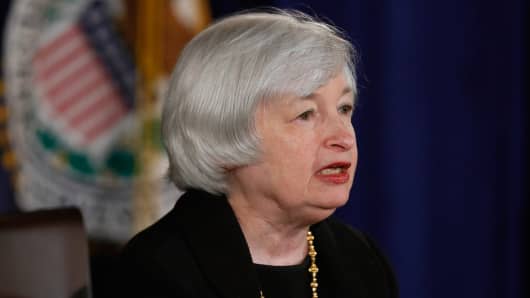1. The Fed needs to drop its phrase "for a considerable time" as seen in its forward guidance "that it likely will be appropriate to maintain the current target range for the federal funds rate for a considerable time after the asset purchase program ends …"
Read MoreWhy the market is losing its faith in the Fed
There are two reasons. One is semantic: The promise of low interest rates is time-dependent, yet the Fed proclaims elsewhere, such as Chair Janet Yellen's September press conference, that its actions are dependent on the incoming data flow. Philadelphia Fed president Charles Plosser has dissented in FOMC votes on these grounds. In her press conference, Yellen attempted to argue that "considerable time" is not a calendar concept, but her explanation was not convincing.
The other reason is more fundamental: If the Fed clings to "considerable time," it likely will mislead the ordinary investor (who takes the commonsense meaning) that it continues to promise easy money for a long time. That will continue to induce imprudent risk-taking. Investors have been trained to expect the Fed to intervene to prevent significant market drops. They did it again when, amid this month's 9-percent market decline, St. Louis Fed President Jim Bullard announced that perhaps QE should be extended. Markets reversed immediately.
2. The Fed should instead adopt a data-dependent phrase such as "maintain the current target range ... for a period of time dependent upon incoming data, including realized and expected progress toward maximum employment and 2 percent inflation." This change is more than semantic.
Read MoreWhat traders are watching while they wait for the Fed
Here the Fed should not (and likely would not) be offering a false assurance of prolonged easy money, but it may offer an assurance that if the U.S. economy should severely slow down or even fall into relapse for whatever reason—euro-zone, China, etc.—then it will maintain monetary accommodation. In short, the Fed should not be offering a floor on stock prices, but it may offer a "best efforts" floor on the economy. In any event, the case for the current ultra-accommodation is weak.
3. The Fed should spell out more clearly how it takes financial stability into account in monetary policy, e.g. its tolerance for "reaching for yield." In other words, it needs to develop a systematic and coherent statement of how it assesses financial asset prices, not just a throwaway line in its semi-annual report to Congress of the sort that caused a market flap in mid-July this year.
Indeed, research done by the Fed itself points in that direction. In an academic paper co-written by former Fed governor Jeremy Stein, ("Monetary Policy and Long-Term Real Rates," Journal of Financial Economics, forthcoming) Stein and his co-author, Samuel G. Hanson, document the evidence that monetary policy has surprisingly strong effects on long-term Treasury risk premia. In that kind of framework, the Fed should share its view with the market of the impact of monetary policy on asset prices.
Read MoreHousing is waking up to a new hangover
Overall, the Fed has had a mixed record recently as to what it's doing and when. We can all join in wishing them clarity of communication in Wednesday's statement. Since 2008, we have asserted that markets have been driven by monetary policy. There is abundant liquidity in the U.S. economy. At some point, the Fed needs to get out of the way and allow free markets to work. Free markets will clear and reach a supply versus demand equilibrium. Until the Fed is removed from the equation, there is no way to guess where that equilibrium is. I admit it may be a bit painful, but it is time.
As a final cautionary and perhaps cynical note: we are weeks away from an election. Do not look for the Fed to change too much that might be seen has having political sway. No matter how timely, we may have to wait until the election passes to see if they have the courage to take tougher steps.



